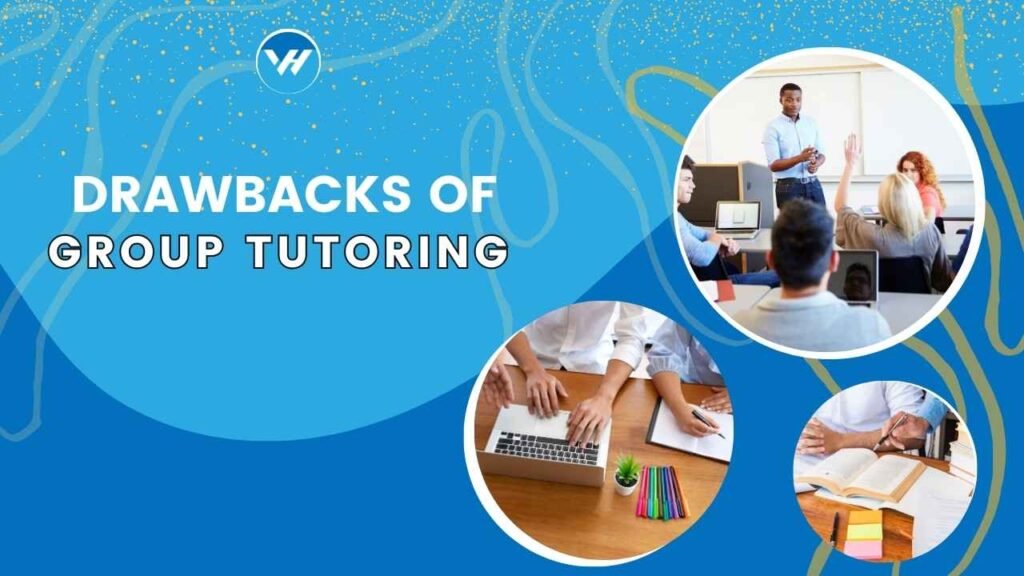Group tutoring is often seen as a cost-effective and collaborative way to enhance learning, but it comes with several drawbacks that can hinder the educational experience. While learning in a group can provide a sense of camaraderie and shared knowledge, it also presents significant challenges that can impact individual learning outcomes.

Table of Contents
ToggleWhat is Group Tutoring?
Definition and Overview
Group tutoring involves one or more instructors teaching multiple students simultaneously. This format is commonly used in schools, tutoring centers, and online platforms, aiming to provide a collaborative learning environment.
Common Formats and Settings
Group tutoring can take place in various settings, including classrooms, online video calls, or community centers. The groups can range from small (3-5 students) to large (10-15 students or more), depending on the subject and the instructor’s preference.
Limited Individual Attention
Instructor’s Divided Focus
One of the primary drawbacks of group tutoring is the limited individual attention each student receives. The instructor’s focus is divided among several students, making it challenging to cater to individual needs.
Less Personalized Feedback
In a group setting, personalized feedback is often sacrificed. Instructors may not have the time to provide detailed feedback to each student, which can hinder individual progress and understanding.
Varying Learning Paces
Fast Learners vs. Slow Learners
In any group, there will be students who grasp concepts quickly and those who need more time. This disparity can cause frustration for both groups: fast learners may feel bored, while slower learners may feel pressured and overwhelmed.
Difficulty in Addressing Individual Needs
The varied learning paces make it difficult for instructors to address individual needs adequately. Some students may require more explanations or different teaching methods, which is hard to provide in a group setting.
Group Dynamics and Peer Pressure
Dominant Students
In group tutoring, dominant students can monopolize discussions, leaving less assertive students with fewer opportunities to participate and ask questions.
Shy or Introverted Students
Shy or introverted students may feel intimidated in a group setting, making them less likely to engage or ask for help when needed.
Impact on Learning Atmosphere
Negative group dynamics, such as competition or cliques, can create an unwelcoming learning atmosphere, which can be detrimental to students’ educational experience.
Scheduling Conflicts
Coordinating Multiple Schedules
Scheduling group tutoring sessions can be challenging as it requires coordinating the availability of multiple students and the instructor, often leading to compromises that might not suit everyone.
Limited Flexibility
Group sessions are typically less flexible in terms of timing and pace. If a student misses a session, catching up can be difficult, especially if the group moves on to new topics.
Distractions and Off-Topic Discussions
Managing Group Behavior
In a group setting, managing behavior and keeping students focused can be challenging. Distractions and off-topic discussions can consume valuable tutoring time.
Time Management Challenges
Time management becomes crucial in group tutoring, as the instructor must balance covering the curriculum with managing group interactions, which can be time-consuming.
Ineffective for Complex Subjects
Need for Individual Guidance
Complex subjects often require individual attention to ensure thorough understanding. Group tutoring may not provide the depth of explanation needed for advanced topics.
Difficulty in Addressing Advanced Questions
Instructors may struggle to address advanced or specific questions in a group setting, as these often require one-on-one interaction and detailed explanation.
Emotional and Social Drawbacks
Anxiety and Stress
Group tutoring can cause anxiety and stress for some students, especially those who are uncomfortable speaking in front of others or feel judged by their peers.
Negative Group Dynamics
Negative group dynamics, such as bullying or exclusion, can affect students’ emotional well-being and hinder their ability to focus and learn.
Inefficiency for Exam Preparation
Focus on General Topics
Group tutoring often focuses on general topics rather than specific exam preparation. This broad approach may not be effective for students needing targeted revision.
Lack of Intensive Review Sessions
Intensive, individualized review sessions are often necessary for effective exam preparation, which group tutoring typically cannot provide.
Quality of Instruction
Varied Instructor Competence
The quality of instruction in group tutoring can vary significantly. Not all instructors are adept at managing group dynamics and ensuring each student’s needs are met.
Inconsistent Teaching Methods
Different instructors may use inconsistent teaching methods, leading to confusion and a lack of continuity in learning.
Limited Feedback Mechanisms
Inadequate Assessment Opportunities
Group tutoring sessions may not provide adequate opportunities for individual assessment, making it hard to track each student’s progress accurately.
Delay in Receiving Feedback
Feedback is often delayed in group settings as the instructor has to review the work of multiple students, leading to slower academic growth.
Dependency on Group Interaction
Reliance on Peer Support
Students in group tutoring sessions may become overly reliant on peer support, which can hinder the development of independent learning skills.
Lack of Self-Study Skills
Group tutoring might not promote self-study skills as effectively as individual tutoring, where students are encouraged to learn and solve problems independently.
Financial Considerations
Cost vs. Benefit Analysis
While group tutoring is generally cheaper than individual tutoring, the cost-benefit ratio may not be favorable if the drawbacks significantly impact learning outcomes.
Hidden Costs
There may be hidden costs associated with group tutoring, such as additional materials or resources required for effective learning.
Comparing Group Tutoring with Individual Tutoring
Pros and Cons
Group tutoring offers social learning benefits but comes with significant drawbacks compared to individual tutoring, which provides personalized attention and tailored instruction.
Situations Where Individual Tutoring Excels
Individual tutoring excels in situations requiring focused, one-on-one interaction, such as complex subjects, exam preparation, and personalized feedback.
Virtual Help: An Alternative Solution
Overview of Virtual Help
Virtual Help is an online platform with iOS and Android apps that connect students with tutors for personalized assistance and assignment help.
Benefits of Using Virtual Help
Using Virtual Help, students can access one-on-one tutoring tailored to their needs, ensuring personalized attention and flexibility in scheduling.
How to Get Started with Virtual Help
Getting started with Virtual Help is easy. Download the app, create an account, and find a tutor that fits your needs. The platform offers a wide range of subjects and expert tutors to choose from.
Conclusion
While group tutoring offers some benefits, such as social interaction and cost-effectiveness, the drawbacks often outweigh these advantages. Limited individual attention, varying learning paces, and scheduling conflicts can significantly impact the effectiveness of group tutoring. For a more personalized and effective learning experience, individual tutoring or platforms like Virtual Help provide better alternatives.
FAQs
What are the main disadvantages of group tutoring?
Group tutoring often lacks individual attention, has varying learning paces, and can be impacted by negative group dynamics and scheduling conflicts.
How can group tutoring affect shy students?
Shy students may feel intimidated in group settings, leading to reduced participation and engagement, which can hinder their learning progress.
Is group tutoring effective for exam preparation?
Group tutoring is generally less effective for exam preparation due to its broad focus and lack of intensive, individualized review sessions.
Why is individual tutoring often better than group tutoring?
Individual tutoring provides personalized attention, tailored instruction, and flexible scheduling, making it more effective for addressing specific learning needs.
How can Virtual Help improve the tutoring experience?
Virtual Help offers personalized, one-on-one tutoring sessions with expert tutors, ensuring individualized attention, flexibility, and targeted assistance for students.





